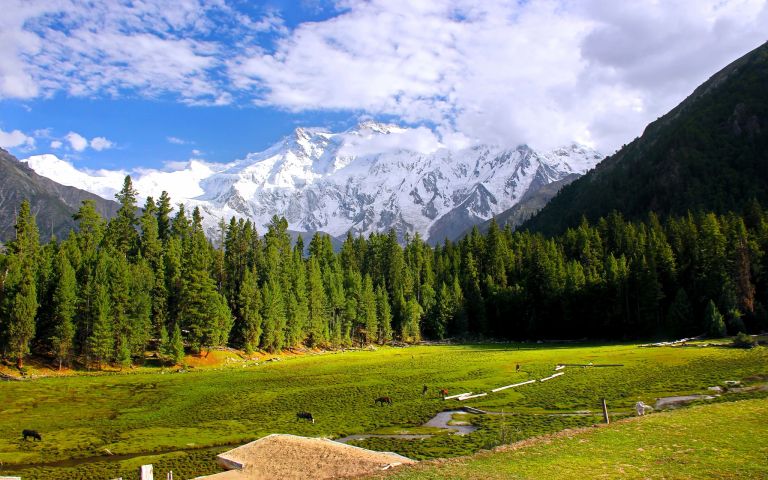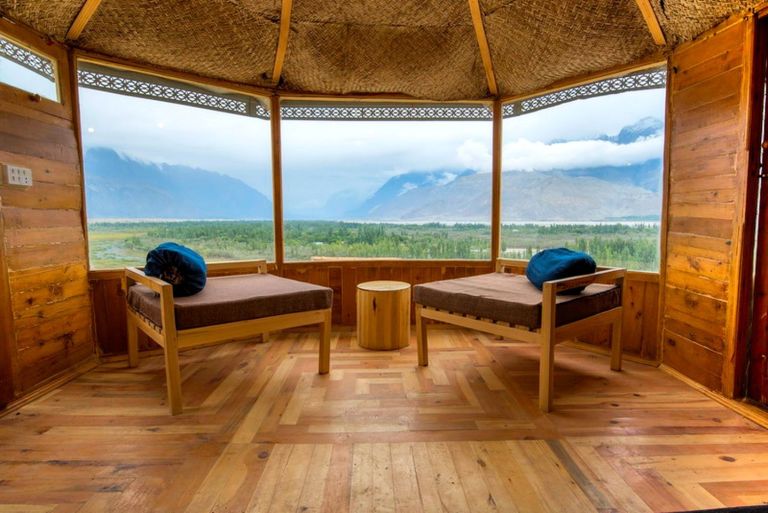Back to the roots with this exciting programme in one of the most stunning regions in the Indian subcontinent: Gilgit-Baltistan, the northern province of Pakistan with its famous Hunza Valley, Karakoram Highway, mighty forts and the Khunjerab Pass going all the way to China.
The region is known for its many high mountains and is home to five of the eight-thousanders and has even more than fifty peaks over 7.000 meters! Three of the world’s longest glaciers outside the polar regions are also found in the north of Pakistan: the Biafo Glacier, the Baltoro Glacier and the Batura Glacier, as well as several alpine lakes. The most important towns are Skardu, Gilgit and Karimabad from which most expeditions depart. The region has so much to offer as there are many valleys, passes, peaks and glaciers which all have their own uniqueness and often offer splendid views over the mountains. It is also populated by friendly, welcoming people who show genuine interest and you’ll be able to have true connection and an exclusive insight in a fascinating culture, which was long isolated from the rest of the world before the arrival of the Karakoram Highway.
It’s not easy to make a choice with so many options to choose from and yes, you’ll be obliged to come back several times to this wonderful region! But whether you choose to hike, go on a jeep safari or do horseback riding, you’ll always be amazed and every region has something special about it, so there is no wrong choice!
We offer four different packages:
1. Shandur Pass (June - end of October)
2. Hindu Kush (June - end of September)
3. Yarkhun Valley (June - end of September)
4. Kaghan Valley (June - end of September)
5. Nanga Parbat (June - end of October)
Note that flights from Islamabad to Gilgit/Skardu are sometimes canceled, in which case we need to drive for two days. Also make sure you have enough time to take your PCR-test in the end.
Shandur Pass
The Shandur Pass, is located in the Hinduraj Mountains in the Chitral District in Khyber Pakhtunkhwa in Pakistan. The pass reaches an altitude of 3738 m and connects the Chitral district with the Gilgit district in Pakistan's Karakorum. The highest polo field in the world is located on a 3728 m high plateau near the pass, where a tournament has been held every year since 1936. A three-day festival has now developed around the polo tournament, which is held in July every year.
The region is only accessible by 4WD on the unpaved road of the Shandur Pass; from November to May the pass is impassable due to snow and ice. The Chitral District, where the Shandur Pass is located, is one of the most remote areas in the world, being accessible only intermittently via four mountain passes or through the Kunar Valley of Afghanistan via Jalalabad all year round.
All passes to Chitral are over 3,000 meters above sea level and are impassable for months during winter. The four passes are the Dorah Pass and the Broghol Pass which lead into the Wakhan Corridor into Afghanistan while only the Lowari Pass connects to Peshawar and the Shandur Pass to Gilgit in Pakistan.
The Hinduraj mountains in northern Pakistan are divided with lakes, rivers and glaciers and the Shandur plateau with the Shandur Lake is fed with water from the glaciers of the surrounding mountains. The excess water of Shandur Lake drains through the Gilgit River, where trout swim. In Chitral folklore, the mythical spirit Shhawanan descends from the mountains to bathe in the evening. In the spring, when the snow has melted, the grass grows on the plateau and forms the best basis for the galloping horses.
The plateau is divided into two distinct landscaped sections. One part consists of the lake, the polo field and huts of the Laspur tribe of Chitral. The other part lies in the south-north extension and is called "Langar" or "Kukush". This site had a forest in the past and is used by the Ghizer and Laspur people.
Since 1936, teams from Gilgit and Chitral have held a traditional polo tournament annually, also known as Polo at the Roof of the World. The tournament is played in an original rather than the modern form of polo. The patronage for this tournament used to be taken over by a prince (Raja), prince (Mir) or king (Mehtar) of the region. Around 20,000 people now come to this polo tournament and festival over the three days. Polo is played in many parts of the world and is an important sport for Pakistanis. Many Pakistanis play polo from childhood and there is a playing field in almost every place in northern Pakistan. The tournament dates back to British Maj Evelyn Cobb, who discovered the high pitch and initiated the tournament. At the start of the game, a band will play local music. If a goal is scored, the goal scorer must bring the ball to the center line with his right hand, because then the band plays for the goal scorer and he then has to throw the ball in the air. This is called Thompq.
Polo has historical roots in ancient Persia around 600 BC. From there it spread to Arabia and India with Islamic expansion. From India, the game made its way to Great Britain and became an Olympic discipline in 1900.
Dance and music performances take place on the plateau in the evenings during the festival, which now takes place from July 7th to 9th every year. A campsite has been set up to accommodate the many festival visitors. Originally it was just a polo tournament, today it has been supplemented by an open-air cultural festival where performances are also performed.
Swat Valley and Kalash Valley
Besides the Shandur Pass, we’ll also visit the Swat Valley and Kalash Valley at the beginning of our itinerary so you’ll truly get a good taste of the best Pakistan has to offer. This part will be done by car while on our way to Shandur Pass.
Swat Valley is located in the Khyber Pakhtunkhwa Province of Pakistan and borders Gilgit-Baltistan and Afghanistan. It is named after the Swat River and the area is known as the Switzerland of Pakistan because of its lush green fields and beautiful deep forest on the hills. There are several historical sites in the area where we can find petroglyphs and stupas.
The Kalasha Valleys are north of Swat and are located in the Chitral district and are dominated by the Hindu Kush mountain range. They are inhabited by the Kalash people with their own culture, language and although most of them are converted to Islam, a part of them still practice their own religion, which could best be described as a form of ancient Hinduism. Many of them fled from the Taliban in Afghanistan to start a new life in Pakistan and this ethnic minority is under protection of the government of Pakistan. There are three main valleys with Bumburet being the largest. The other two are called Biriu and Ayun. The culture is known for their colored-clothed women with unique and beautiful clothing and jewelry.
Itinerary Shandur Pass Horseback riding:
Note that flights from Islamabad to Gilgit/Skardu are sometimes canceled, in which case we need to drive for two days. Also make sure you have enough time to take your PCR-test in the end.
Day 1: Arrival in Islamabad and transfer to your hotel.
Day 2: Drive to Swat Valley
Day 3: Scenic drive to Chitral through Lawori Pass
Day 4: Exploration of the Kalasha Valley
Day 5: Scenic drive to Mastuj
Day 6: Horseback riding to the Shandur pass: camping
Day 7: Exploring Shandur Lake by horse: camping
Day 8: Horseback riding to Tero: camping
Day 9: Horseback riding to Phunder: camping
Day 10: Horseback riding to Gupis camping
Day 11: Horseback riding to Gakuch: Hotel
Day 12: Continue to Sher Qila: camping
Day 13: Transfer to Gilgit by car
Day 14: Drive to Besham
Day 15: Continue to Islamabad
Day 16: Departure from Islamabad (add an extra day for PCR if needed)
Price:
1 person: 8499 usd
2 persons: 5299 usd per person
3 persons: 4899 usd per person
4 persons: 4799 usd per person
** Single supplement: 990 usd



























